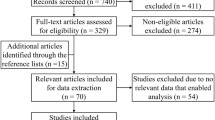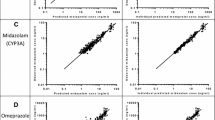Abstract
Purpose
Cytochrome P450 (CYP) 3A plays an important role in the metabolism of many clinically used drugs and exhibits substantial between-subject variability (BSV) in activity. Current methods to assess variability in CYP3A activity have limitations and there remains a need for a minimally invasive clinically translatable strategy to define CYP3A activity. The purpose of this study was to evaluate the potential for a caffeine metabolic ratio to describe variability in CYP3A activity.
Methods
The metabolic ratio 1,3,7-trimethyluric acid (TMU) to caffeine was evaluated as a biomarker to describe variability in CYP3A activity in a cohort (n = 28) of healthy 21 to 35-year-old males. Midazolam, caffeine, and TMU concentrations were assessed at baseline and following dosing of rifampicin (300 mg daily) for 7 days.
Results
At baseline, correlation coefficients for the relationship between apparent oral midazolam clearance (CL/F) with caffeine/TMU ratio measured at 3, 4, and 6 h post dose were 0.82, 0.79, and 0.65, respectively. The strength of correlations was retained post rifampicin dosing; 0.72, 0.87, and 0.82 for the ratios at 3, 4, and 6 h, respectively. Weaker correlations were observed between the change in midazolam CL/F and change in caffeine/TMU ratio post/pre-rifampicin dosing.
Conclusion
BSV in CYP3A activity was well described by caffeine/TMU ratios pre- and post-induction. The caffeine/TMU ratio may be a convenient tool to assess BSV in CYP3A activity, but assessment of caffeine/TMU ratio alone is unlikely to account for all sources of variability in CYP3A activity.

Similar content being viewed by others
References
Zanger UM, Schwab M (2013) Cytochrome P450 enzymes in drug metabolism: regulation of gene expression, enzyme activities, and impact of genetic variation. Pharmacol Ther 138(1):103–141
Lamba JK, Lin YS, Schuetz EG, Thummel KE (2002) Genetic contribution to variable human CYP3A-mediated metabolism. Adv Drug Deliv Rev 54(10):1271–1294
Wang Z, Lin YS, Zheng XE, Senn T, Hashizume T, Scian M, Dickmann LJ, Nelson SD, Baillie TA, Hebert MF, Blough D, Davis CL, Thummel KE (2012) An inducible cytochrome P450 3A4-dependent vitamin D catabolic pathway. Mol Pharmacol 81(4):498–509
Paine MF, Hart HL, Ludington SS, Haining RL, Rettie AE, Zeldin DC (2006) The human intestinal cytochrome P450 “pie”. Drug Metab Dispos 34(5):880–886
Lamba V, Panetta JC, Strom S, Schuetz EG (2010) Genetic predictors of interindividual variability in hepatic CYP3A4 expression. J Pharmacol Exp Ther 332(3):1088–1099
Bosilkovska M, Samer CF, Déglon J, Rebsamen M, Staub C, Dayer P, Walder B, Desmeules JA, Daali Y (2014) Geneva cocktail for cytochrome P450 and P-glycoprotein activity assessment using dried blood spots. Clin Pharmacol Ther 96(3):10
de Wit D, Guchelaar HJ, den Hartigh J, Gelderblom H, van Erp NP (2015) Individualized dosing of tyrosine kinase inhibitors: are we there yet? Drug Discov Today 20(1):18–36
Sim SC, Kacevska M, Ingelman-Sundberg M (2013) Pharmacogenomics of drug-metabolizing enzymes: a recent update on clinical implications and endogenous effects. Pharm J 13(1):1–11
Rowland A, van Dyk M, Mangoni AA, Miners JO, McKinnon RA, Wiese MD, Rowland A, Kichenadasse G, Gurney H, Sorich MJ (2017) Kinase inhibitor pharmacokinetics: comprehensive summary and roadmap for addressing inter-individual variability in exposure. Expert Opin Drug Metab Toxicol 13(1):31–49
Malaty LI, Kuper JJ (1999) Drug interactions of HIV protease inhibitors. Drug Saf 20(2):147–169
Rahmioglu N, Heaton J, Clement G, Gill R, Surdulescu G, Zlobecka K, Hodgkiss D, Ma Y, Hider RC, Smith NW, Ahmadi KR (2011) Genetic epidemiology of induced CYP3A4 activity. Pharmacogenet Genomics 21(10):642–651
van Dyk M et al (2016) A novel approach for the simultaneous quantification of 18 small molecule kinase inhibitors in human plasma. J Chromatogr B 1033:17–26
Smith, B., et al.,(2015) Across the continuum: DMPK experiences from preclinical to market. Proc 2015 APSA-ASCEPT JSM, O112
Goulooze SC, Galettis P, Boddy AV, Martin JH (2016) Monte Carlo simulations of the clinical benefits from therapeutic drug monitoring of sunitinib. Cancer Chemother Pharmacol 78(1):209–216
Kim HY, Martin JH, Mclachlan AJ, Boddy AV (2017) Precision dosing of targeted anticancer drugs—challenges in the real world. Transl Cancer Res 6:S1500–S1511
Hohmann N, Kocheise F, Carls A, Burhenne J, Haefeli WE, Mikus G (2015) Midazolam microdose to determine systemic and pre-systemic metabolic CYP3A activity in humans. Br J Clin Pharmacol 79(2):278–285
Jurica, J. and A. Sulcova,2012 Determination of cytochrome P450 metabolic activity using selective markers, in Topics on drug metabolism, J. Paxton, Editor., InTech: Rijeka. p. Ch. 8
Rowland A, van Dyk M, Hopkins AM, Mounzer R, Polasek TM, Rostami-Hodjegan A, Sorich MJ (2018) Physiologically based pharmacokinetic modeling to identify physiological and molecular characteristics driving variability in drug exposure. Clin Pharmacol Ther 104:1219–1228. https://doi.org/10.1002/cpt.1076
Streetman DS, Bertino JS Jr, Nafziger AN (2000) Phenotyping of drug-metabolizing enzymes in adults: a review of in-vivo cytochrome P450 phenotyping probes. Pharmacogenetics 10(3):187–216
Shin KH, Choi MH, Lim KS, Yu KS, Jang IJ, Cho JY (2013) Evaluation of endogenous metabolic markers of hepatic CYP3A activity using metabolic profiling and midazolam clearance. Clin Pharmacol Ther 94(5):601–609
Fuhr U, Jetter A, Kirchheiner J (2007) Appropriate phenotyping procedures for drug metabolizing enzymes and transporters in humans and their simultaneous use in the “cocktail” approach. Clin Pharmacol Ther 81(2):270–283
Galteau MM, Shamsa F (2003) Urinary 6beta-hydroxycortisol: a validated test for evaluating drug induction or drug inhibition mediated through CYP3A in humans and in animals. Eur J Clin Pharmacol 59(10):713–733
Chen Y-C, Gotzkowsky SK, Nafziger AN, Kulawy RW, Rocci ML, Bertino JS, Kashuba ADM (2006) Poor correlation between 6β-hydroxycortisol: cortisol molar ratios and midazolam clearance as measure of hepatic CYP3A activity. Br J Clin Pharmacol 62(2):187–195
Diczfalusy U, Kanebratt KP, Bredberg E, Andersson TB, Böttiger Y, Bertilsson L (2009) 4β-Hydroxycholesterol as an endogenous marker for CYP3A4/5 activity. Stability and half-life of elimination after induction with rifampicin. Br J Clin Pharmacol 67(1):38–43
Miners JO, Birkett DJ (1996) The use of caffeine as a metabolic probe for human drug metabolizing enzymes. Gen Pharmacol 27(2):245–249
Tassaneeyakul W, Mohamed Z, Birkett DJ, McManus ME, Veronese ME, Tukey RH, Quattrochi LC, Gonzalez FJ, Miners JO (1992) Caffeine as a probe for human cytochromes P450: validation using cDNA-expression, immunoinhibition and microsomal kinetic and inhibitor techniques. Pharmacogenetics 2(4):173–183
Tassaneeyakul W, Birkett DJ, McManus ME, Tassaneeyakul W, Veronese ME, Andersson T, Tukey RH, Miners JO (1994) Caffeine metabolism by human hepatic cytochromes p450: contributions of 1A2, 2E1 and 3A isoforms. Biochem Pharmacol 47(10):1767–1776
Tassaneeyakul, W., 1994 In vivo and vitro probes for human cytochromes P450. PhD thesis. , Flinders University of South Australia
van Dyk M, Marshall JC, Sorich MJ, Wood LS, Rowland A (2018) Assessment of inter-racial variability in CYP3A4 activity and inducibility among healthy adult males. Eur J Clin Pharmacol 74:913–920. https://doi.org/10.1007/s00228-018-2450-4
Kennedy MJ, Scripture CD, Kashuba AD, Scott CS, Gaedigk A, Kearns GL (2004) Activities of cytochrome P450 1A2, N-acetyltransferase 2, xanthine oxidase, and cytochrome P450 2D6 are unaltered in children with cystic fibrosis. Clin Pharmacol Ther 75(3):163–171
Nordmark A, Lundgren S, Cnattingius S, Rane A (1999) Dietary caffeine as a probe agent for assessment of cytochrome P4501A2 activity in random urine samples. Br J Clin Pharmacol 47(4):397–402
Rowland A, van Dyk M, Warncken D, Mangoni AA, Sorich MJ, Rowland A (2018) Evaluation of modafinil as a perpetrator of metabolic drug-drug interactions. Br J Clin Pharmacol 84:501–509
Hohmann N, Haefeli WE, Mikus G (2016) CYP3A activity: towards dose adaptation to the individual. Expert Opin Drug Metab Toxicol 12(5):479–497
Klein K, Zanger UM (2013) Pharmacogenomics of cytochrome P450 3A4: recent progress toward the “missing heritability” problem. Front Genet 4:12
Elens L, van Gelder T, Hesselink DA, Haufroid V, van Schaik RHN (2013) CYP3A4*22: promising newly identified CYP3A4 variant allele for personalizing pharmacotherapy. Pharmacogenomics 14(1):47–62
Tseng E, Walsky RL, Luzietti RA, Harris JJ, Kosa RE, Goosen TC, Zientek MA, Obach RS (2014) Relative contributions of cytochrome CYP3A4 versus CYP3A5 for CYP3A-cleared drugs assessed in vitro using a CYP3A4-selective inactivator (CYP3cide). Drug Metab Dispos 42(7):1163–1173
Kinirons MT, O’Shea D, Downing TE, Fitzwilliam AT, Joellenbeck L, Groopman JD, Wilkinson GR, Wood AJJ (1993) Absence of correlations among three putative in vivo probes of human cytochrome P4503A activity in young healthy men. Clin Pharmacol Ther 54(6):621–629
Diczfalusy U et al (2011) 4beta-Hydroxycholesterol, an endogenous marker of CYP3A4/5 activity in humans. Br J Clin Pharmacol 71(2):183–189
Bjorkhem-Bergman L, Backstrom T, Nylen H, Ronquist-Nii Y, Bredberg E, Andersson TB, Bertilsson L, Diczfalusy U (2013) Comparison of endogenous 4beta-hydroxycholesterol with midazolam as markers for CYP3A4 induction by rifampicin. Drug Metab Dispos 41(8):1488–1493
Gu L et al (1992) Biotransformation of caffeine, paraxanthine, theobromine and theophylline by cDNA-expressed human CYP1A2 and CYP2E1. Pharmacogenetics 2(2):73–77
Kot M, Daniel WA (2008) The relative contribution of human cytochrome P450 isoforms to the four caffeine oxidation pathways: an in vitro comparative study with cDNA-expressed P450s including CYP2C isoforms. Biochem Pharmacol 76(4):543–551
Funding
This study was supported by a project grant (1100179) from the National Health and Medical Research Council of Australia.
Author information
Authors and Affiliations
Contributions
Participated in research design: MVD, JOM, MJS, and AR.
Recruitment and screening of trial participants: MVD.
Performed sample analysis: MVD and LSW.
Performed data analysis: MVD, JCM, and AR.
Wrote or contributed to the writing of the manuscript: MVD, JOM, JCM, LSW, MJS, and AR.
Corresponding author
Ethics declarations
The study protocol was approved by the Southern Adelaide Clinical Human Research Ethics Committee (SAHREC 11.15), and informed written consent was obtained from each participant.
Conflict of interest
All authors declare that there are no conflicts of interest. Linda S Wood and Jean-Claude Marshall are employees and stock holders of Pfizer World Wide Research and Development.
Additional information
Publisher’s note
Springer Nature remains neutral with regard to jurisdictional claims in published maps and institutional affiliations.
Electronic supplementary material
Supplementary Table 1
(PDF 564 kb)
Rights and permissions
About this article
Cite this article
van Dyk, M., Miners, J.O., Marshall, JC. et al. Identification of the caffeine to trimethyluric acid ratio as a dietary biomarker to characterise variability in cytochrome P450 3A activity. Eur J Clin Pharmacol 75, 1211–1218 (2019). https://doi.org/10.1007/s00228-019-02682-5
Received:
Accepted:
Published:
Issue Date:
DOI: https://doi.org/10.1007/s00228-019-02682-5




